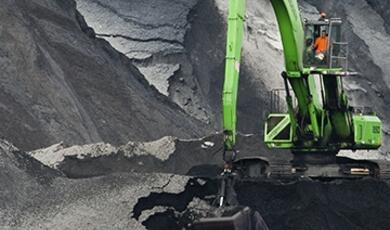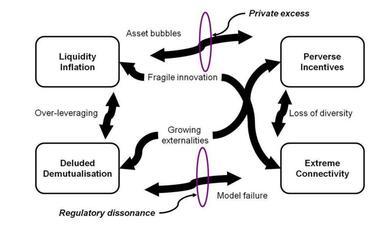Is the growth in the emerging economies additional or are we growing more slowly?
Share
- Details
- Transcript
- Audio
- Downloads
- Extra Reading
Speakers look at the limits to world economic growth from an environmental and economic perspective. Will inflation caused by rising primary product prices be likely to be the key constraint on economic growth? Douglas McWilliams, Thras Moraitis and Mike McWilliams consider whether this constraint will bite at a sufficiently slow rate for the impact of the extra growth in emerging economies to mean that the West will have to grow more slowly.
This is part of the lecture series, The Greatest Ever World Economic Event: How the transformation of two thirds of the world's population from starvation to moderate prosperity will affect us all.
The other lectures in this series are as follows:
The Greatest Ever Economic Change
A New Theory of Economic Growth
How to make Western Economies more Competitive
Will there be a shortage of spending power?
The Winning and Losing Nations
Download Transcript
11 OCTOBER 2012
IS THE ECONOMIC GROWTH FROM THE EMERGING ECONOMIES ADDITIONAL?
PROFESSOR DOUGLAS MCWILLIAMS,
with THRAS MORAITIS and MICHAEL MCWILLIAMS
Tonight we are looking at the constraints on world economic growth from shortages of primary resources. Obviously, although I have considerable experience in looking at the outlook for demand, I am not an expert on supplies of natural resources. I have therefore invited two people who do know a lot about these things. Thras Moraitis is a member of the executive board of Xstrata, the global commodities business and Michael McWilliams, my brother, is the global head of hydro power for the engineering consultants Mott MacDonald. I am very grateful indeed to both of them for joining us this evening. Welcome, Thras and Mike.
Summary
What we concluded in the first lecture last month was that the Second Great Transformation – the industrialisation of two thirds of the world’s population – was indeed the greatest ever world economic change.
The scale of the shift in advantage was remarkable, but even more so the speed of this. Essentially China is achieving in 50 years what it took us more than 150 years to achieve. One of the consequences of this has been that attitudes in the emerging Eastern economies have adjusted more slowly than they might have done had the pace of economic transformation been slower. And so there is a discontinuity between economic behaviour and economic performance. One of the consequences is that the emerging economies have become supercompetitive because they have not allowed their emerging prosperity to dull their economic edge.
What we are now turning to is the global envelope of total economic growth within which these changes in the balance of advantage are taking place.
The underlying analysis
The underlying thesis is that the limits to economic growth are likely to be essentially economic, with the consequences of shortages of natural resources or environmental difficulties incorporated into the relationship between the supply of primary products and the demand for them.
The thesis, therefore, is that if there is a shortage of – say – energy, that this will limit the pace at which the world economy can grow because excess growth would lead to too fast a rise in the price of energy which would add to world inflation, squeeze living standards and create disinflationary policies that in turn would slow down growth.
Objective
What we are therefore doing today is looking at the various different constraints on world economic growth, to see to what extent they will hold back the total of world economic growth. To the extent to which world growth is constrained, it is likely that – with the East in a supercompetitive state – economic growth in the Western economies will be limited.
When we have considered the extent to which growth is limited, we will look at some policy measures that might alleviate these constraints.
Overview
In addition to the impact of shortages of primary commodities, there are two other factors that we can consider that might constrain the rate of world economic growth.
The first of these is essentially economic – that the disruptive effect of the extent of the change that is taking place will on balance damage growth.
The second is the environment – many have claimed that there are environmental limits to growth. Is this so?
We will look at these in turn and then look at four areas of primary product supply where there might also be shortages of supplies that might – probably through the price mechanism that I have outlined above – cause the pace of world economic growth to be limited –food, minerals, energy and water. Again we will look at each of these in turn. Thras will cover minerals and Mike will cover energy and water.
They will both ask if there are technologies that can change the impact of these constraints.
We will then ask ‘If growth is constrained what are the implications – for the emerging economies and for the Western economies?’
Finally we will look at what policy measures will allow faster growth by limiting the shortages which might hold growth back?
The disruptive effect of economic uncertainty
It would be naïve to imagine that the major shift in world economic leadership will automatically proceed smoothly. In the past, wars and the change in world economic leadership from the UK to the US have both proved disruptive.
In this case, I have argued (and my arguments have been adopted by others like Charles Dumas and Sir Samuel Brittan) that one of the effects of the shifting world economic leadership from the West to the East has been to create a surplus of savings in the world as world GDP has increasingly emerged in countries which have a high savings ratio like China (enhanced by their policy of managing their exchange rates) and diminishingly in countries like the US with a low savings ratio.
The consequent excess of savings has held down world interest rates.
On its own, this would not be a problem. But many investors – for example pension funds in the West - have had unrealistic expectations of nominal interest rates and indeed have been encouraged in these by the regulatory authorities, based on the actuarial extrapolation of history.
To achieve these nominal returns in a world with a savings surplus they have taken on excess risk. Let’s face it, in retrospect the idea of taking on bonds backed by mortgages handed out to sub prime borrowers - where sub prime means they are unlikely to be able to repay – and where the main basis of keeping the loans alive has been grossing them up in line with the increase in property values to cover the non-existent interest payments doesn’t look in the cold light of day to be a great business proposition.
I had an exchange of letters with Sir Howard Davies, the then head of the FSA, about reducing the appropriate target return for pension fund investments – he preferred to go with the actuarial extrapolation of past trends. As a trustee and member of the investment committee of the GEC pension fund, I managed to stop them buying such bonds – the fact that a bond salesman had found it worth his while to fly the Atlantic simply to see us should have been warning in itself!
The financial crisis that started with the collapse of the sub prime mortgage bond market is still with us, five years on, and like Sir Mervyn King I would judge that its aftermath is likely to be with us for perhaps 5-10 more years, constraining growth as balance sheets are rebuilt and governments retrench. Indeed, the impact on government borrowing, which was added to by grossly overoptimistic assumptions on which they built their spending plans, is probably with us for a generation of 20 years or more. This will constrain economic growth in the West, and through its knockon effects, in the East as well. I will deal in more detail with the links between the world financial crisis and the shift from West to East in my lectures next year.
The second economic problem that is likely to constrain world economic growth is the problem of the euro. Again, I am going to deal with this in detail next year but the subbed down version is that – whatever the underlying economics of the euro – trying to introduce it at a time when the West is losing competitiveness against the East, when Europe in general is losing competitiveness against the rest of the West and when Southern Europe is losing competitiveness against Northern Europe is, to put it mildly, difficult.
We don’t know how the euro problem will pan out but as things stand there seems to be two possible choices – either very slow (ie probably negative) economic growth as the uncompetitive economies try to adjust by internal devaluations (cutting wages etc) or the disruption to banking systems and other institutions that would result from a euro breakup and the consequent defaults that would result. My instinct is that the latter will cost less in the long run but we can’t be certain about this. What we can be certain about is that either will be costly.
And of course we cannot rule out other economic mistakes that would constrain growth as well.
Environment
Let me turn now to the environment.
The Stern Review[1] states that ‘with 5-6°C warming - which is a real possibility for the next century - existing models that include the risk of abrupt and large-scale climate change estimate an average 5-10% loss in global GDP, with poor countries suffering costs in excess of 10% of GDP.
In other parts of the Stern Review this is subbed down to an estimated loss of GDP on an annual basis of 5%.
However, the Review has been heavily criticised by Rt Hon Peter Lilley PC MP[2], who argues that the Stern headlines are exaggerated.
For the purposes of this assessment, we do not need to take a view on the reality either of global warming or of its impact but merely on whether it is likely to lead to measures that have an impact on the costs of primary products, particularly energy.
At present, the extent to which long term fears of environmental damage is leading to policies designed to mitigate such damage varies between different geographies. European policy has developed further than policy in either the US or in emerging economies such as China. But it is clear that in most areas there is an intention to incentivise the use of renewable resources.
Whether this becomes a serious constraint on growth will depend on the extent to which rapid development of non-renewables such as shale gas become probable. We look at this in more detail in the section on energy.
Food supplies
The first of the primary resources that I would like to consider is food.
I have relied essentially on the FAO report ‘How to Feed the World in 2050’[3]. This report argues that feeding the world is possible, but that there will be a cost. This cost is likely to be reflected in prices.
The estimated cost is $209 billion of gross investment annually (at 2009 prices) will be required compared with $142 billion investment annually on the same price basis over the past decade.
But the FAO has also looked at what might be a ‘game changer’ – genetically modified (GM) food. The FAO study on this estimates that the impact is to reduce the average world price of food by 13-40% (though no timeframe is suggested)[4].
What is clear is that the current regimes for the development of GM food are different in different areas. Most GM food so far has been grown in either the US or in Latin America (indeed the rapid growth of agricultural production and exports based on GM technologies has been an important factor behind Brazil’s growth to become the world’s 6th largest economy[5]). If European economies, which have had varying approaches to the application of GM technologies but which have been largely restrictive on the whole, continue largely to eschew them, not only will they face competitive challenges from the emerging economies from the cost side but also from the technological side.
So it is likely that there will be some upward pressure on costs from food shortages, though it is possible that GM technologies can mitigate these. Of course food production is intimately connected with the availability of water so we will revisit this in the section looking at water supplies.
Minerals
A multi-decade secular change in demand for commodities is underway.
Over 1bn people will move to cities in the next decade – over 1m/week. Income trends correlate strongly with increased urbanisation - as does demand for commodities.
Commodities display different demand profiles as economies evolve. Currently China dominates demand and growth in demand.
But India is already decisive in some commodity sectors which translates directly into commodity demand growth. The first of this series of Gresham lectures pointed out that India’s economy is likely to overtake the Chinese economy to become the world’s largest around 2050. India’s domestic supply is already unable to meet demand in many commodities and this problem is likely to be enhanced.
A broader base of growth markets is expected to become increasingly important in the coming years. It is worth noting that multi-decade structural price trends are not unprecedented but (as pointed out in the first of this series of Gresham lectures) the industrialisation of China and other BRICs represents a demand shift an order of magnitude greater than those in USA, Europe and Japan. Despite the current cyclical slowdown, China remains the key driver of secular demand, despite managed moderation of growth.
Meanwhile, maintaining supply from existing sources is becoming increasingly challenging.
Amid rapidly declining ore grades and aging mines, declining head grades mean producers have to “run harder to stand still”. For example, a current problem is that copper supply is falling short of expectations.
To handle this issue, natural resource companies are being compelled to access future resources in ‘new’ geographies.
A substantial proportion of future capital investment is in these new geographies where insufficient infrastructure and associated costs in new geographies drive cost and complexity.
The vast majority of mega projects have experienced cost and schedule over-runs while increasingly complex social and government issues are retarding new production.
So there would be potential problems with the world supply of commodities and in particular minerals against reasonable growth expectations even if the underlying climate for production was highly favourable.
But the climate for investment is not favourable.
First, we are seeing changing regulations to give a stronger voice to community opposition to mining projects, for example the new IFC Standard 7.
Second, complex re-negotiations and land purchase requirements are emerging. There is increased competition for land between agriculture and mining. One example is that the Queensland government are introducing legislation around “strategic cropping land”.
Third, there is growing activism against mining, for example the Friends of the Earth legal challenge to coal projects in Australia in respect of climate change.
And finally there is resource nationalism which shows itself in increased regulations/taxes/ nationalisation.
So against the background where increased globalisation and consolidation are bringing about key challenges for the extractive industries, a symbiotic relationship between producers, governments and other stakeholders is essential.
Governments can help alleviate some of the important bottlenecks.
So let me recapitulate: a secular change in demand for commodities is being driven by the industrialisation and urbanisation of over a third of the world’s population;
The supply of many commodities remains unable to bridge the demand gap;
Prices for commodities are likely to remain above historical averages for some time;
Governments are inadvertently hampering the development of much needed new sources of key commodities; and
A symbiotic understanding and approach to resource development is essential to remove unnecessary bottlenecks in supply.
Energy
Let me start with some of the basic facts.
The main current sources of energy for the world are oil, coal and gas[6].
The main uses are domestic, industry, transport and electricity (of course electricity has domestic and industrial uses)[7].
The main users of energy are the US, the other parts of the OECD and China[8]. But China, India and Africa have more than 50% of the world’s population and consume less than one-quarter of the OECD average per capita consumption[9].
The main likely growth in consumption over the period to 2035 is China, India, Brazil, Indonesia, Russia and the Middle East[10]. The main likely growth in fuel use is in fuels other than oil and coal.
Meanwhile, although oil and to a lesser extent gas – and this depends on the extent to which there are new discoveries – are likely to become depleted over the next 25 years, most other fuels are unlikely to be[11] even if demand growth is rapid.
However price is the critical variable. The Cebr base assumption for oil prices has a price of oil staying above $150 for much of the period to 2020, though the more optimistic scenario – which assumes a high elasticity of supply for gas in particular – has the price falling eventually to around $80.
Water
Unlike energy, all water is renewable.
Even consumptive uses, predominantly irrigation, result in recycling through transpiration and precipitation.
There is plenty of water around – 2/3 of the world’s surface is covered in water - or is there?
Three per cent of the world’s water is fresh and of that 10% is accessible in lakes and rivers.
There are around 40 x 1013 cubic metres of renewable “Blue Water” each year in the world. Against this, the average water requirement for food production is 4 cubic metres per day and world population is around 7 billion so one-quarter of the available water must be harvested to meet demand[12].
Looking to the future there are six key issues[13].
1. Location of water
People used to live where water is available; now some 1 billion people live in regions where there is insufficient water;
2. Population Growth
By 2035 the world’s population will increase from 7 billion to around 8.6 billion (UN estimates);
3. Urbanisation
By 2035 the percentage of urban population will grow from 52% to 62% - nearly 2 billion more people in urban environments; (UN estimates);
4. Changing diet
With growing wealth the consumption of meat is increasing; 10 times as much water is needed per kilo of beef compared with bread, raising the average per capita requirement (UN waterfootprint.org);
5. Climate Change
Impacts on precipitation levels will vary, but more intense rainfall will be harder to harvests;
6. Transboundary issues
Downstream users in water stressed regions of major rivers such as the Nile, Indus and Jordan are increasingly concerned about upstream abstractions, and about treaties which were made in days of lower population and water demand.
On balance, my assessment is that there will still be sufficient water in 2035, but there is a need for considerable investment in storage, transfer and treatment infrastructure and in improved food production technology.
Conclusion
We have looked at the likely constraints on world economic growth and concluded that these are likely to exist.
The aftermath of the Western financial crisis is likely to be a constraint on growth, both in the West and in the East. The euro crisis will either constrain growth through its deflationary effects if it stays in existence and through the disruptive effects if it breaks up.
The environment may hold back growth, through rising prices if not necessarily directly.
There are likely to be shortages of minerals to support rapid growth unless government policies change.
Further substantial investment in food and water supplies will be necessary to support even the modest growth that we envisage.
There will also need to be energy investment, and on pessimistic assumptions about energy supplies – a high energy price.
So world economic growth is forecast to average about 2½% on our base scenario. We do, however have a more optimistic scenario with growth around 3%, which is on the high side historically , giving some idea of what might happen if primary product price inflation can be contained.
Against this background what is the prospect for Western Europe? Our analysis indicates that growth would be sluggish whatever the circumstances because of the knock-on effect of the euro problems and also the impact of government policies that have been more designed to consume the fruits of economic growth than to sustain economic growth.
But on top of this there are two new ‘killer applications’ in GM food and shale gas that have the possibility of improving the trade-off between growth and inflation. The Americas are already taking advantage of the cheaper price of energy. As a result, the price of oil is now $20 cheaper in the US than in Europe. And gas in the US now costs a quarter of the price of oil. Both of these factors are already giving US businesses a significant economic advantage over European businesses. And as we have seen, GM technologies will also convey a significant cost advantage. We in Europe are only dipping our toes in the water so far with these technologies. If we fail to take advantage of them, we could be left in a position where the European economy struggles to avoid decline.
Worldwide, the policies most likely to help sustain world economic growth are those which minimise the supply constraints on the economy and help combine environmental efficiency with economic efficiency.
But in Europe, on top of this, we run the risk of having our economic growth squeezed out altogether if we allow other parts of the world to run ahead in their use of the key technologies while we restrict their development based on our concerns about their effect.
My best ever economic forecasts have been proved wrong. The whole purpose of making such forecasts is to find ways of improving on the worse outcomes. The analysis we have seen today looking at the environment, food, minerals, energy and water has highlighted what we need to do so as best to alleviate the constraints that otherwise would limit world economic growth. If we ignore these issues, the fruits of growth in increased prosperity and reduced poverty will not be achieved. And if we ignore these issues in Europe, we could find ourselves even more relatively impoverished as the competitive challenge increases.
© Professor Douglas McWilliams et al 2012
Endnotes:
[1] http://siteresources.worldbank.org/INTINDONESIA/Resources/226271-1170911056314/3428109-1174614780539/SternReviewEng.pdf The Stern Review: The Economics of Climate Change P9
[2] WHAT IS WRONG WITH STERN? The Failings of the Stern Review of the Economics of Climate Change, Peter Lilley MP, The Global Warming Policy Foundation, GWPF Report 9, London, September 2012
[3] http://www.fao.org/fileadmin/templates/wsfs/docs/expert_paper/How_to_Feed_the_World_in_2050.pdf
[4] http://www.fao.org/docrep/015/ap016e/ap016e.pdf
[5] Cebr Global Prospects, December 2011
[6] Golden Rules for a Golden Age of Gas, IEA, 2012
[7]Key World Energy Statistics, IEA, 2012
[8] Key World Energy Statistics, IEA, 2012
[9] Key World Energy Statistics, IEA, 2012
[10] Key World Energy Statistics, IEA, 2012
[11] Various sources including:
Survey of Energy Resource, WEC, 2010
Statistical Review of World Energy, BP, June 2012
Key World Energy Statistics, IEA, 2012
Golden Rules for a Golden Age of Gas, IEA, 2012
[12] UN Data: Water in a Changing World, 2009; Global Water Volume, USGS
[13] UN Department of Economic and Social Affaires database
Part of:
This event was on Thu, 11 Oct 2012
Support Gresham
Gresham College has offered an outstanding education to the public free of charge for over 400 years. Today, Gresham plays an important role in fostering a love of learning and a greater understanding of ourselves and the world around us. Your donation will help to widen our reach and to broaden our audience, allowing more people to benefit from a high-quality education from some of the brightest minds.


 Login
Login











